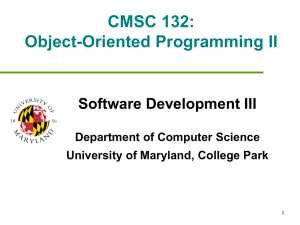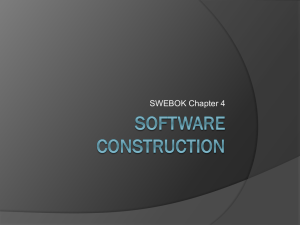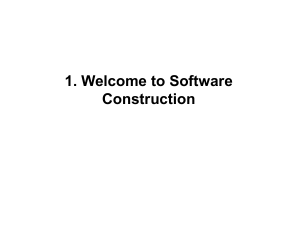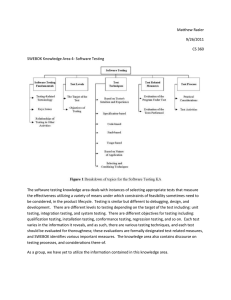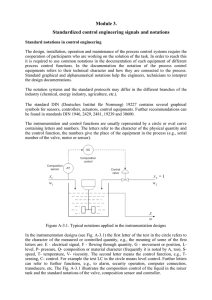SWEBOK Chapter 4 Software Construction
advertisement
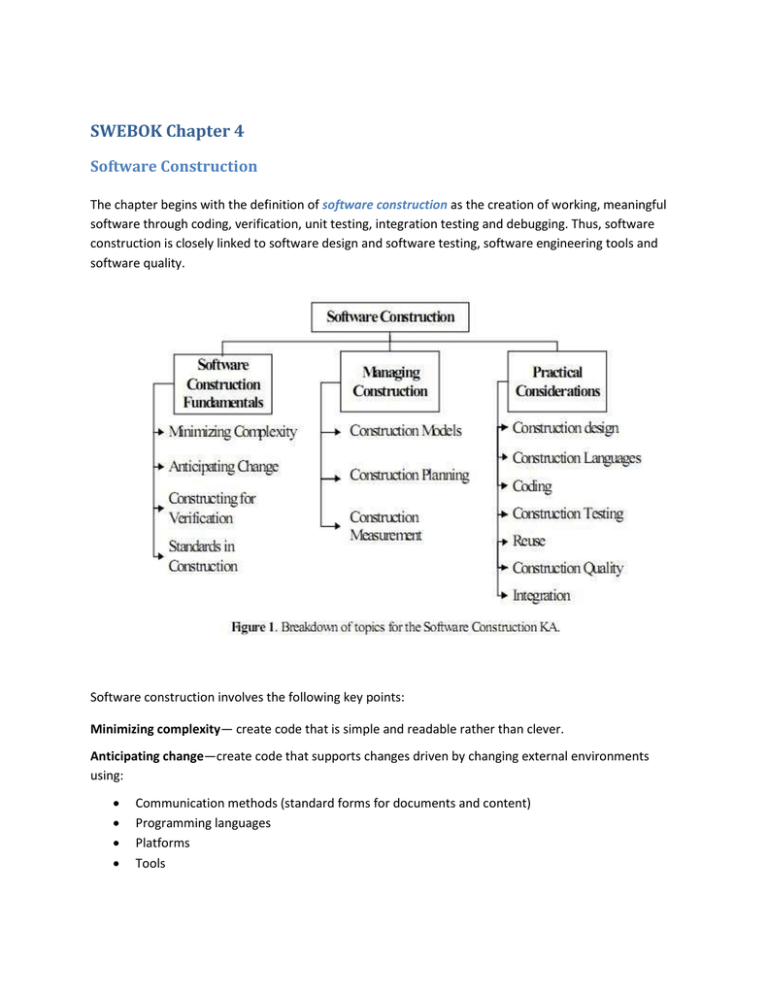
SWEBOK Chapter 4 Software Construction The chapter begins with the definition of software construction as the creation of working, meaningful software through coding, verification, unit testing, integration testing and debugging. Thus, software construction is closely linked to software design and software testing, software engineering tools and software quality. Software construction involves the following key points: Minimizing complexity— create code that is simple and readable rather than clever. Anticipating change—create code that supports changes driven by changing external environments using: Communication methods (standard forms for documents and content) Programming languages Platforms Tools Constructing for verification—building software such that faults can easily be discovered by the developers as well as the independent testers. Follow coding standards to support code reviews Unit testing Organizing code to support automated testing Restricted use of complex language structures Standards in construction—include: Use of external standards (IEEE) Use of internal standards (organization) Managing construction involves: Construction models—can be linear (such as waterfall or staged-delivery life cycle models) that emphasize the work preceding construction as a separate activity from construction or iterative (evolutionary prototyping, extreme programming, scrum) that treat construction as an activity occurring concurrently with planning and design. Construction planning—defines the construction method Extent, order and degree to which construction prerequisites are performed prior to construction Order in which components are created and integrated Software quality management processes, Allocation of task assignments Construction measurement—conducted for purposes of managing construction, ensuring quality during construction, and improving the construction process. Measurements may include: Code developed Code modified Code reused Code destroyed Code complexity Code inspection statistics Fault-fix and fault-find rates Effort Scheduling Construction is driven by practical, real-world constraints such as: Construction design—design modifications will need to be made to flesh out the details of higher level software design. Construction languages—all forms of communication by which a human can specify an executable problem solution to a computer. Configuration language Toolkit languages Programming languages Linguistic notations (word-like strings)—should provide an immediate intuitive understanding of what will happen when the software is executed Formal notations (mathematical definitions)—the heart of systems engineering where accuracy, timing and testability are essential Visual notations—depend on visual entities and their placement Coding—strategies implemented for consistency within the software such as error handling and documentation. Construction testing—procedures to reduce the time between when faults are introduced into the code and the time when they are detected. Unit testing Integration testing Reuse—selecting reusable units, databases, test procedures or test data, evaluating the code for reusability and reporting reusability information on new code, procedures or data. Construction Quality—activities that focus on code and artifacts that are closely related to the code— small-scale designs. Unit testing and integration testing Test-first development Code stepping Use of assertions Debugging Technical reviews Static analysis Integration—pulling together the separately constructed routines, classes, components and subsystems as well as other software and hardware. Sequence in which components will be integrated Creating scaffolding to support interim versions of the software Determining the degree of testing and quality work performed on components before integration Testing points for interim versions
